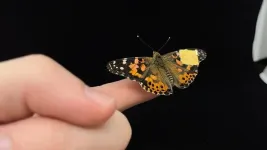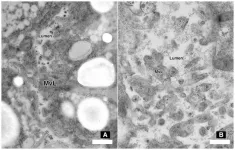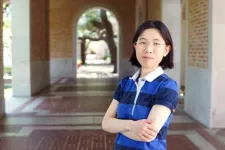(Press-News.org) Irvine, Calif., Jan. 14, 2025 — Researchers at the University of California, Irvine and New York’s Columbia University have embedded transistors in a soft, conformable material to create a biocompatible sensor implant that monitors neurological functions through successive phases of a patient’s development.
In a paper published recently in Nature Communications, the UC Irvine scientists describe their construction of complementary, internal, ion-gated, organic electrochemical transistors that are more amenable chemically, biologically and electronically to living tissues than rigid, silicon-based technologies. The medical device based on these transistors can function in sensitive parts of the body and conform to organ structures even as they grow.
“Advanced electronics have been in development for several decades now, so there is a large repository of available circuit designs. The problem is that most of these transistor and amplifier technologies are not compatible with our physiology,” said co-author Dion Khodagholy, Henry Samueli Faculty Excellence Professor in UC Irvine’s Department of Electrical Engineering and Computer Science. “For our innovation, we used organic polymer materials that are inherently closer to us biologically, and we designed it to interact with ions, because the language of the brain and body is ionic, not electronic.”
In standard bioelectronics, complementary transistors have been composed of different materials to account for different polarities of signals, which, in addition to being unyielding and cumbersome, present the risk of toxicity when implanted in sensitive areas. The team of researchers from UC Irvine and Columbia University worked around this problem by creating its transistors in an asymmetric fashion that enables them to be operated using a single, biocompatible material.
“A transistor is like a simple valve that controls the flow of current. In our transistors, the physical process that controls this modulation is governed by the electrochemical doping and de-doping of the channel,” said first author Duncan Wisniewski, Columbia University Ph.D. candidate during the project who is now a visiting scholar in the UC Irvine Department of Electrical Engineering and Computer Science. “By designing devices with asymmetrical contacts, we can control the doping location in the channel and switch the focus from negative potential to positive potential. This design approach allows us to make a complementary device using a single material.”
He added that arraying transistors into a smaller, single-polymer material greatly simplifies the fabrication process, enabling large-scale manufacturing and opportunities to expand the technology beyond the original neurological application to almost any biopotential processes.
Khodagholy, who heads the UC Irvine Translational Neuroelectronics Laboratory, which recently moved to Irvine from Columbia University, said that his team’s work has the added benefit of scalability: “You can make different device sizes and still maintain this complementarity, and you can even change the material, which makes this innovation applicable in multiple situations.”
Another advantage highlighted in the Nature Communications paper is that the device can be implanted in a developing animal and withstand transitions in tissue structures as the organism grows, something that is not possible with hard, silicon-based implants.
“This characteristic will make the device particularly useful in pediatric applications,” said co-author Jennifer Gelinas, UC Irvine associate professor of anatomy and neurobiology as well as pediatrics, who’s also a physician at Children’s Hospital of Orange County.
“We demonstrated our ability to create robust complementary, integrated circuits that are capable of high-quality acquisition and processing of biological signals,” Khodagholy said. Complementary, internal, ion-gated, organic electrochemical transistors “will substantially broaden the application of bioelectronics to devices that have traditionally relied on bulky, nonbiocompatible components.”
Joining Khodagholy, Gelinas and Wisniewski on this project were Claudia Cea, Liang Ma, Alexander Ranschaert, Onni Rauhala and Zifang Zhao of Columbia University. The work was supported by the National Institutes of Health and the National Science Foundation.
About the University of California, Irvine: Founded in 1965, UC Irvine is a member of the prestigious Association of American Universities and is ranked among the nation’s top 10 public universities by U.S. News & World Report. The campus has produced five Nobel laureates and is known for its academic achievement, premier research, innovation and anteater mascot. Led by Chancellor Howard Gillman, UC Irvine has more than 36,000 students and offers 224 degree programs. It’s located in one of the world’s safest and most economically vibrant communities and is Orange County’s second-largest employer, contributing $7 billion annually to the local economy and $8 billion statewide. For more on UC Irvine, visit www.uci.edu.
Media access: Radio programs/stations may, for a fee, use an on-campus studio with a Comrex IP audio codec to interview UC Irvine faculty and experts, subject to availability and university approval. For more UC Irvine news, visit news.uci.edu. Additional resources for journalists may be found at https://news.uci.edu/media-resources.
END
UC Irvine, Columbia University researchers invent soft, bioelectronic sensor implant
Device conforms to body’s tissues, allowing brain monitoring through development
2025-01-14
ELSE PRESS RELEASES FROM THIS DATE:
Harnessing nature to defend soybean roots
2025-01-14
The microscopic soybean cyst nematode (SCN) may be small, but it has a massive impact. This pest latches onto soybean roots, feeding on their nutrients and leaving a trail of destruction that costs farmers billions in yield losses each year. Unfortunately, current methods to combat SCN are faltering as the pest grows resistant to traditional controls. But new research is now offering a glimmer of hope.
A collaborative team of scientists from BASF Agricultural Solutions and the Advanced Bioimaging Laboratory at the Donald Danforth Plant Science Center are working on a potential solution: ...
Yes, college students gain holiday weight too—but in the form of muscle not fat
2025-01-14
With the holidays behind us, many Americans are seeing the numbers on the scale go up a pound or two. In fact, data shows that many American midlife and older adults gain 1 to 1.5 pounds over the November through January holiday period. Though not harmful on its own, even a small amount of holiday weight gain in the form of fat can negatively affect health. People often fail to lose the extra weight, which leads to significant cumulative weight gain over the years and contributes to health concerns.
Based on new research, we now know that college students gain the same amount of weight as older ...
Beach guardians: How hidden microbes protect coastal waters in a changing climate
2025-01-14
A hidden world teeming with life lies below beach sands. New Stanford-led research sheds light on how microbial communities in coastal groundwater respond to infiltrating seawater. The study, published Dec. 22 in Environmental Microbiology, reveals the diversity of microbial life inhabiting these critical ecosystems and what might happen if they are inundated by rising seas.
“Beaches can act as a filter between land and sea, processing groundwater and associated chemicals before they reach the ocean,” said study co-first author Jessica Bullington, a Ph.D. student in Earth system science in the Stanford Doerr School of Sustainability. “Understanding ...
Rice researchers unlock new insights into tellurene, paving the way for next-gen electronics
2025-01-14
HOUSTON – (Jan. 14, 2025) – To describe how matter works at infinitesimal scales, researchers designate collective behaviors with single concepts ⎯ like calling a group of birds flying in sync a “flock” or “murmuration.” Known as quasiparticles, the phenomena these concepts refer to could be the key to next-generation technologies.
In a recent study published in Science Advances, a team of researchers led by Shengxi Huang, associate professor of electrical and computer engineering and materials science and nanoengineering at Rice, describe how one such type of quasiparticle ⎯ polarons ⎯ behaves in tellurene, a nanomaterial first synthesized ...
New potential treatment for inherited blinding disease retinitis pigmentosa
2025-01-14
Two new compounds may be able to treat retinitis pigmentosa, a group of inherited eye diseases that cause blindness. The compounds, described in a study published January 14th in the open-access journal PLOS Biology by Beata Jastrzebska from Case Western Reserve University, US, and colleagues, were identified using a virtual screening approach.
In retinitis pigmentosa, the retina protein rhodopsin is often misfolded due to genetic mutations, causing retinal cells to die off and leading to progressive blindness. Small molecules to correct rhodopsin folding are urgently needed to treat the estimated 100,000 ...
Following a 2005 policy, episiotomy rates have reduced in France without an overall increase in anal sphincter injuries during labor, with more research needed to confirm the safest rate of episiotomi
2025-01-14
Following a 2005 policy, episiotomy rates have reduced in France without an overall increase in anal sphincter injuries during labor, with more research needed to confirm the safest rate of episiotomies and the risks to specific subgroups
In your coverage, please use this URL to provide access to the freely available paper in PLOS Medicine: http://journals.plos.org/plosmedicine/article?id=10.1371/journal.pmed.1004501
Article title: Episiotomies and obstetric anal sphincter injuries following a restrictive episiotomy policy in France: An analysis of the 2010, 2016, and 2021 National Perinatal Surveys
Author countries: France, Switzerland
Funding: ...
Rats anticipate location of food-guarding robots when foraging
2025-01-14
Researchers find that rats create neurological maps of places to avoid after experiencing a threat and think about these locations when exhibiting worry-related behaviors. These findings—which A. David Redish of the University of Minnesota, US, and colleagues presented in the open-access journal PLOS Biology on January 14th—may provide insight into the neuroscience of common psychological conditions like anxiety.
There are many theories as to why people experience anxiety. One is that anxiety is associated with a psychological phenomenon called “approach-avoidance conflict,” where ...
The American Association for Anatomy announces their Highest Distinctions of 2025
2025-01-14
ROCKVILLE, MD—January 14, 2025—The American Association for Anatomy (AAA) is thrilled to announce the recipients of their 2025 Spring Awards. Each awardee will be formally recognized at the Anatomy Connected 2025 Closing Awards Ceremony on March 31, in Portland, Oregon.
The Spring Awards include the three highest distinctions awarded by AAA: the Henry Gray Scientific Award, the A.J. Ladman Exemplary Service Award, and the Henry Gray Distinguished Educator Award. The winners of these awards, along with the others on this list, are gathered through a nomination process conducted by their peers ...
Diving deep into dopamine
2025-01-14
Positive feedback is helpful for learning, but usually, our greatest lessons actually come from failure— and a new project at the University of Pittsburgh aims to uncover the neural mechanisms behind this phenomenon.
Helen Schwerdt, assistant professor of bioengineering at Pitt’s Swanson School of Engineering, received a five-year, $2.5 million R01 award from the National Institutes of Health (NIH) to study dopamine’s role in learning. Schwerdt’s team develops novel multimodal neural interfaces ...
Automatic speech recognition on par with humans in noisy conditions
2025-01-14
Automatic speech recognition (ASR) has made incredible advances in the past few years, especially for widely spoken languages such as English. Prior to 2020, it was typically assumed that human abilities for speech recognition far exceeded automatic systems, yet some current systems have started to match human performance. The goal in developing ASR systems has always been to lower the error rate, regardless of how people perform in the same environment. After all, not even people will recognize speech with 100% accuracy in a noisy environment.
In a new study, UZH computational linguistics specialist Eleanor Chodroff and a fellow researcher from Cambridge ...
LAST 30 PRESS RELEASES:
How human interaction drove evolution to make bears less aggressive
National Poll: Few parents offer teens guidance on healthy eating during holiday season
Cannabis derivatives could provide new ovarian cancer treatments
Raising strong yeast as a petroleum substitute
Clues to the origin of hot Jupiters hidden in their orbits
Canada’s reduced pledge to Global Fund will impact domestic health
1 in 4 children with major traumatic injuries not cared for in pediatric trauma centres
Duke and Duke-NUS’ joint cross-population research to uncover "East-West" differences in disease and care
Scientists to ‘spy’ on cancer- immune cell interactions using quantum technology breakthrough
Tech savvy users have most digital concerns
Making lighter work of calculating fluid and heat flow
Normalizing blood sugar can halve heart attack risk
Lowering blood sugar cuts heart attack risk in people with prediabetes
Study links genetic variants to risk of blinding eye disease in premature infants
Non-opioid ‘pain sponge’ therapy halts cartilage degeneration and relieves chronic pain
AI can pick up cultural values by mimicking how kids learn
China’s ecological redlines offer fast track to 30 x 30 global conservation goal
Invisible indoor threats: emerging household contaminants and their growing risks to human health
Adding antibody treatment to chemo boosts outcomes for children with rare cancer
Germline pathogenic variants among women without a history of breast cancer
Tanning beds triple melanoma risk, potentially causing broad DNA damage
Unique bond identified as key to viral infection speed
Indoor tanning makes youthful skin much older on a genetic level
Mouse model sheds new light on the causes and potential solutions to human GI problems linked to muscular dystrophy
The Journal of Nuclear Medicine ahead-of-print tip sheet: December 12, 2025
Smarter tools for peering into the microscopic world
Applications open for funding to conduct research in the Kinsey Institute archives
Global measure underestimates the severity of food insecurity
Child survivors of critical illness are missing out on timely follow up care
Risk-based vs annual breast cancer screening / the WISDOM randomized clinical trial
[Press-News.org] UC Irvine, Columbia University researchers invent soft, bioelectronic sensor implantDevice conforms to body’s tissues, allowing brain monitoring through development







